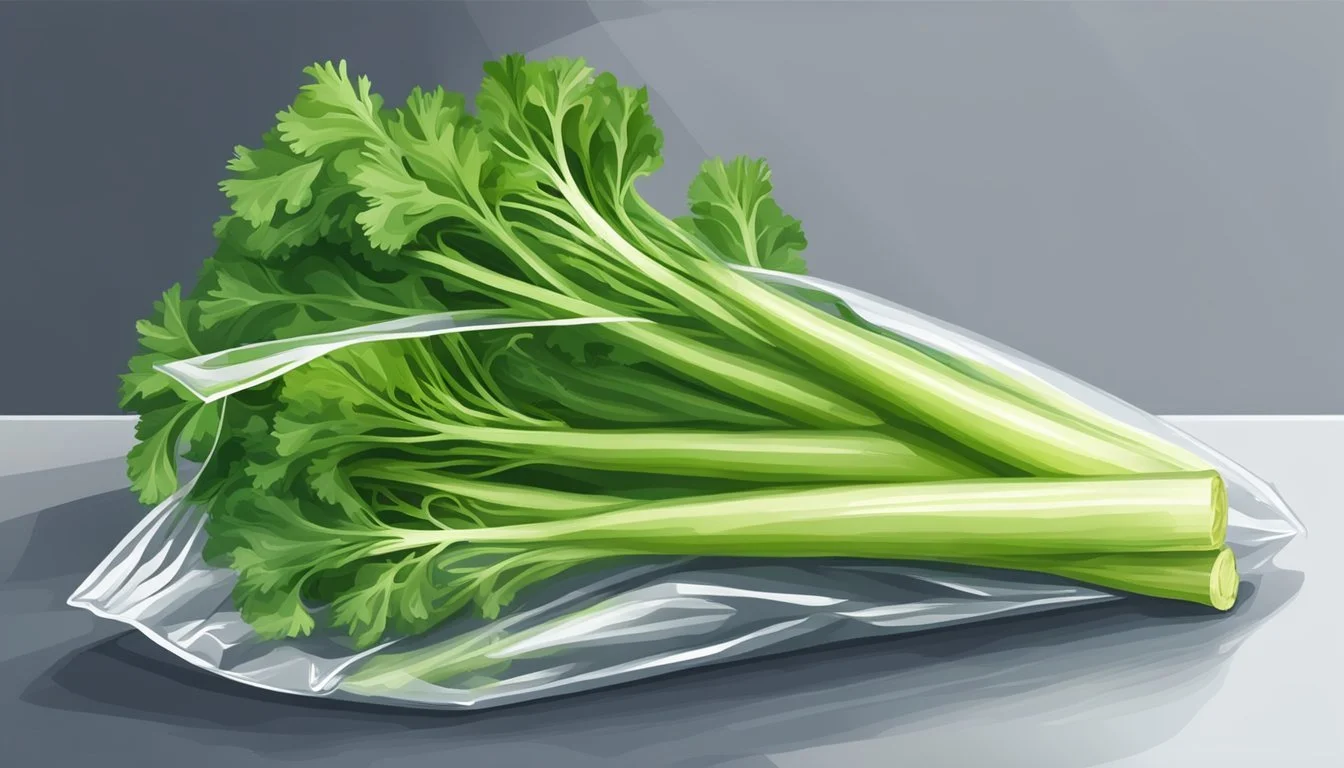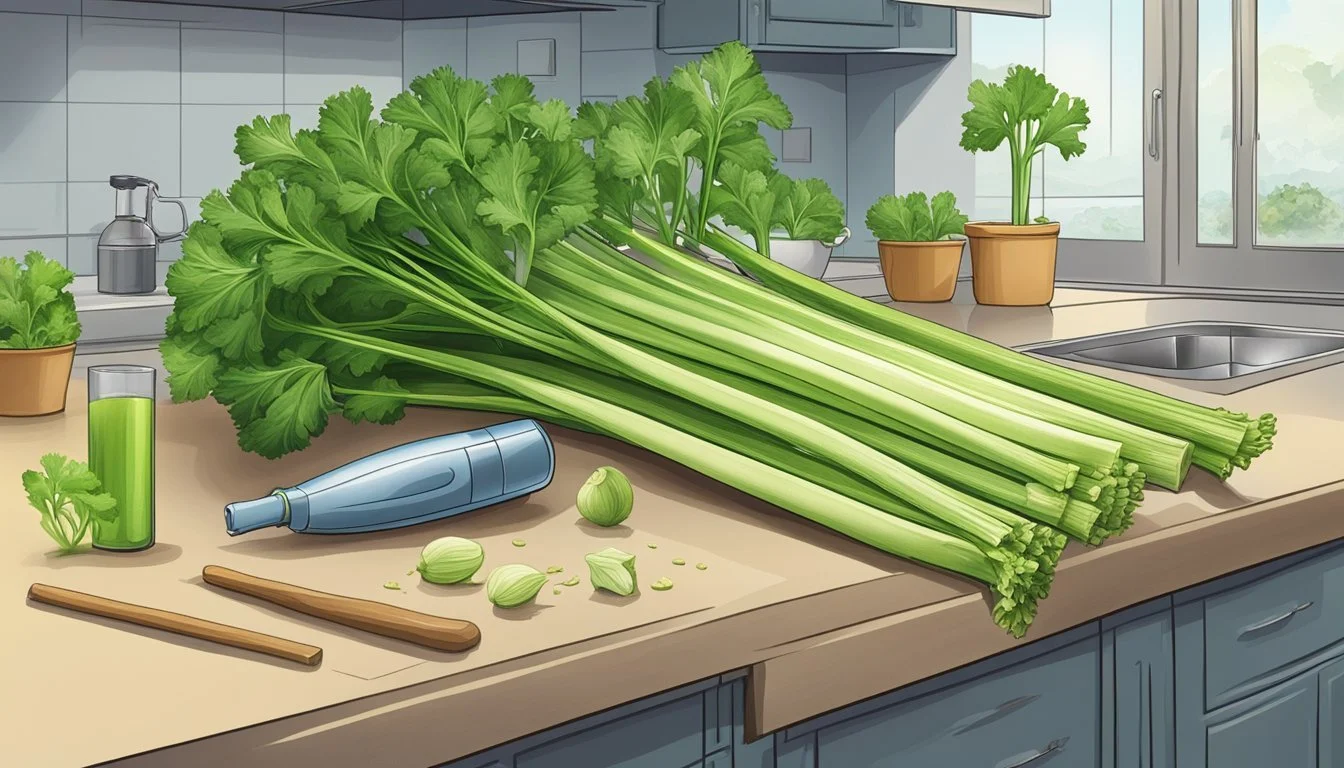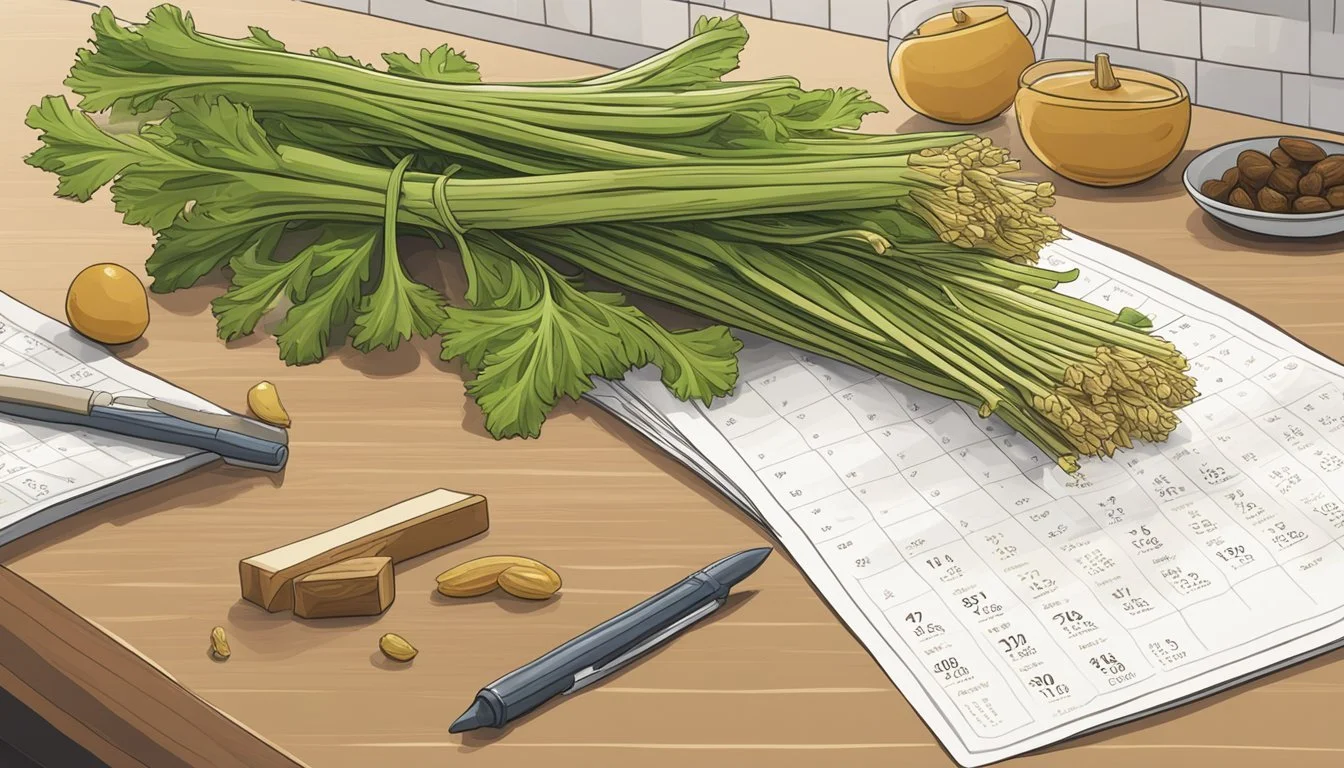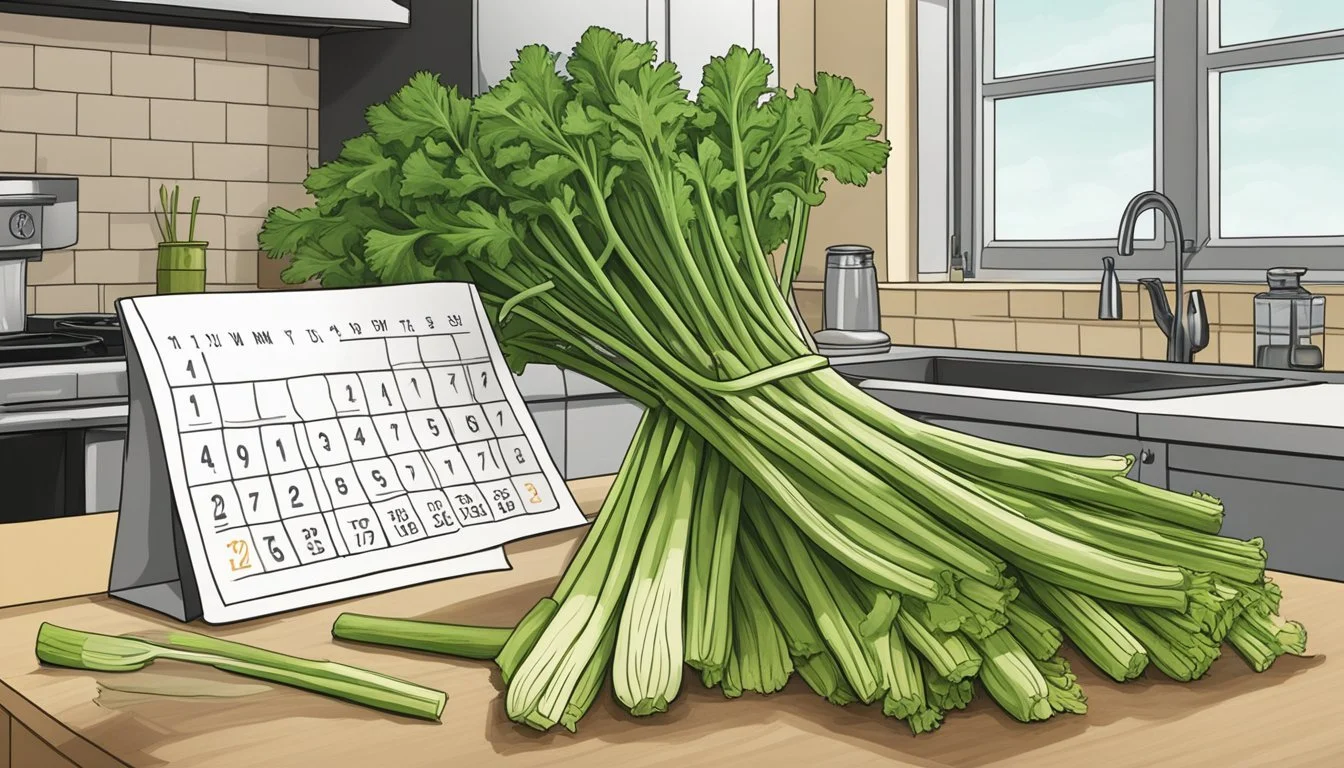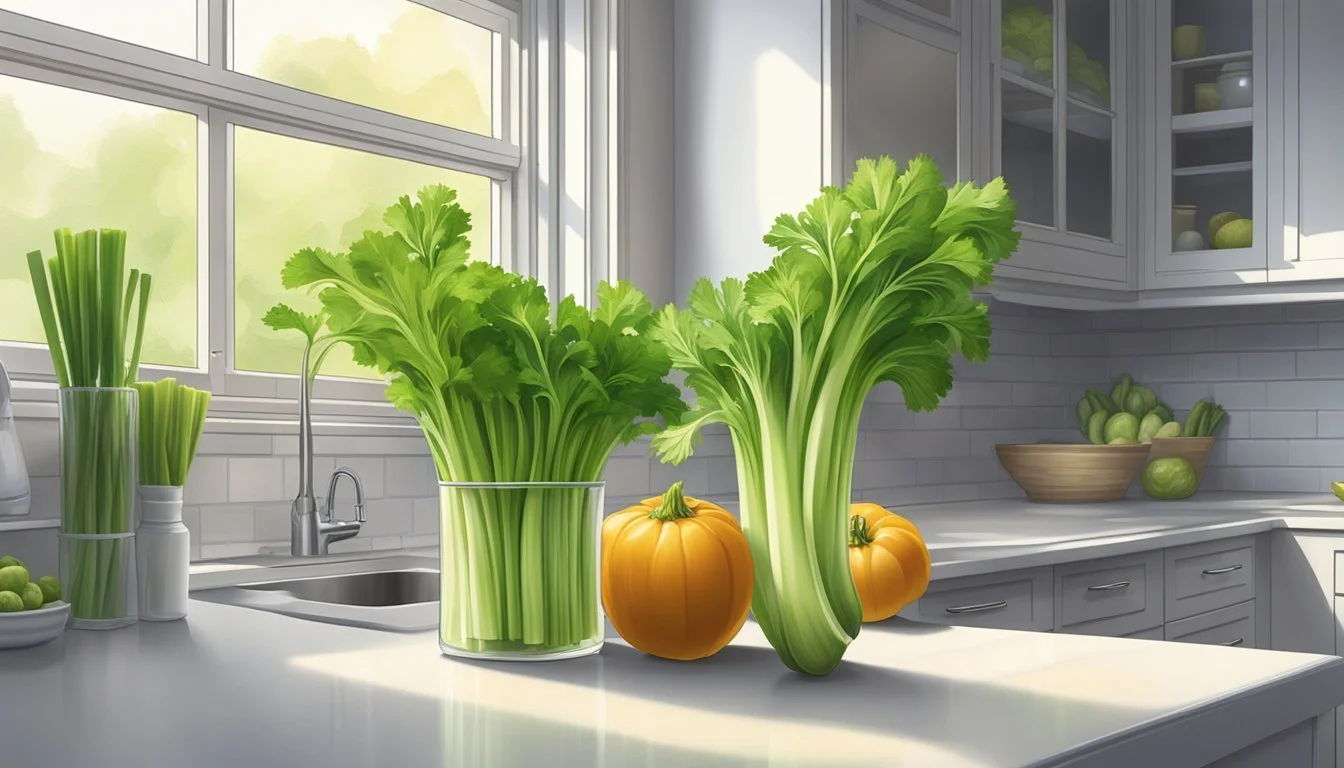How Long Does Celery Last?
Understanding Its Shelf Life and Storage Tips
Celery, a staple in many kitchens, is renowned for its crisp texture and distinct flavor, often used to enhance dishes or served as a healthy snack. How long celery lasts depends on several factors, such as initial freshness, storage methods, and whether it's been cut or kept whole. Generally, when stored properly in the refrigerator, whole celery can remain fresh for up to 2 to 4 weeks.
To maintain celery's freshness for as long as possible, it is crucial to keep it crisp and hydrated. Effective storage methods involve either wrapping the celery snuggly in aluminum foil to lock in moisture without trapping gas, or using a clean, damp paper towel to cover the celery before placing it in the fridge. This helps in mitigating dehydration, a common cause of celery becoming limp or rubbery over time.
If celery does begin to lose its firmness, it can be revitalized by trimming the ends and placing it in ice water for a period, allowing it to regain its characteristic crunch. This technique can give a second life to celery that may otherwise have been discarded, ensuring that this versatile vegetable is used to its full potential with minimal waste.
Understanding Celery
Celery is a versatile vegetable from the Apiaceae family, known for its crisp texture and distinct flavor. It is composed primarily of water and dietary fiber, which makes it a popular choice for healthy snacking and a staple in many culinary dishes from soups to salads.
A single celery plant has several distinct parts, including a bulbous root (celeriac), long fibrous stalks, and leaves, all of which are edible. Nutritionally, celery is low in calories but rich in vitamins such as A, K, and C, as well as minerals like potassium.
When selecting celery, look for firm stalks and fresh, bright leaves. These characteristics typically indicate freshness and can also affect how long this vegetable will last once brought home. On average, celery's crispness is an indicator of its freshness, and a more hydrated stalk will last longer.
Proper storage plays a crucial role in the shelf life of celery. Generally, celery should be kept in the refrigerator to slow down the degradation process related to warmth and light.
Storage Condition Estimated Shelf Life Refrigerator 2 to 4 weeks Room Temperature Up to 4 days
To maintain freshness and extend shelf life, celery can be wrapped in a damp paper towel before placing it in a plastic bag or container. The goal is to keep it hydrated without excess moisture that could promote spoilage. The crisper drawer of the refrigerator is ideal for storing celery due to its ability to regulate humidity and temperature effectively.
Shelf Life of Celery
The shelf life of celery is dependent on whether it is whole or cut, with proper storage methods being crucial for maintaining freshness.
Whole Celery
Whole celery typically maintains its freshness for 3-4 weeks in the refrigerator if stored correctly. To prolong its shelf life, it should be kept in the crisper drawer to ensure it remains crisp and hydrated. Wrapping it tightly in plastic wrap or placing it in a resealable bag can also prevent premature spoilage.
Cut Celery
Cut celery has a slightly shorter shelf life, remaining fresh for about 1-2 weeks in the refrigerator. The key to keeping cut celery fresh is to store them in a secure, air-tight container or wrapped snugly in aluminum foil or plastic to maintain humidity levels and prevent the edges from drying out.
Optimal Storage Methods
Proper storage can significantly extend the lifespan and freshness of celery. Two main storage methods to consider are refrigeration and freezing, depending on how long one plans to keep the celery.
Refrigeration
Celery thrives in cool, humid environments. To store celery in the fridge, one should first rinse the stalks and cut off the ends. Wrapping the celery in a damp paper towel and then placing it in a plastic bag helps maintain the humidity it requires. This can extend the freshness for up to two weeks. For best results, place the wrapped celery in the crisper drawer of the refrigerator, as it provides an ideal environment for preserving crispiness.
Method: Rinse, trim, wrap in damp paper towel, and place in a plastic bag.
Location: Crisper drawer of the refrigerator.
Freezing
Freezing celery is ideal for long-term storage, but it is best used in cooked dishes as it will lose its crispness once thawed. One should blanch celery first before freezing to preserve its flavor, nutrients, and texture. After blanching, place the pieces on a baking sheet lined with parchment paper and freeze for 1 to 2 hours. Once frozen, transfer the celery to an airtight container or freezer bag to prevent freezer burn.
Preparation: Blanch, cool, and dry thoroughly.
Method: Spread on parchment paper, freeze, then store in freezer bag or airtight container.
Use: Recommended for cooked dishes post-thawing.
Factors Affecting Celery Longevity
When it comes to maintaining celery's freshness, several pivotal factors influence its longevity. Understanding these elements ensures that the celery stays crisp and edible for as long as possible.
Moisture: Celery is comprised of about 95% water, which makes it imperative to manage its moisture levels. Excess moisture can lead to rapid degradation, while too little can cause dehydration. Keeping celery hydrated, yet not soggy, is key.
Storage Temperature: A cool environment is ideal for celery storage. The refrigerator provides a consistent temperature that keeps celery fresh. Rapid changes in temperature can shorten its shelf life.
Ethylene Gas: Some fruits and vegetables naturally emit ethylene gas, which can accelerate the ripening process of nearby produce. To prevent premature spoilage, celery should be stored away from high-ethylene producers like apples and bananas.
Airflow: Proper ventilation helps to reduce the accumulation of ethylene gas around celery. Sufficient airflow mitigates moisture buildup, which otherwise leads to spoilage.
By carefully considering these factors, the shelf life of celery can be maximized. It's common for whole celery to remain fresh in the refrigerator for 2 to 4 weeks, while cut celery needs to be used more promptly. Always store celery in a manner that maintains optimal moisture, temperature, and airflow to extend its usability. Keeping it away from ethylene-producing fruits and vegetables will further enhance its longevity.
Signs of Spoilage
Celery's freshness can be ascertained through various signs. Knowing how to detect these signs is crucial in determining if the vegetable has gone bad. Here are key indicators:
Discoloration: One should look for changes in color. Celery that exhibits yellow or brown hues, particularly on the stalks or leaves, is likely past its prime.
Texture: Fresh celery should be crisp. If stalks turn mushy, limp, or soft to the touch, this suggests spoilage. Similarly, leaves that are dry or exhibit sliminess are also indicative of degradation.
Odor: A strong indicator is smell. Fresh celery has a neutral, clean scent. Should there be an off odor, almost foul or sour, it's a clear sign that the celery is no longer suitable for consumption.
Mold: The presence of mold, which may look like white, black, or green fuzzy spots, is a definite sign that celery has spoiled and should not be eaten.
Sliminess: Another visual and tactile cue is a slimy film on the surface of the celery. Once this occurs, the celery has begun to rot and should not be used.
Recognizing these signs can help ensure that the celery one consumes is of good quality and safe to eat. It's essential to inspect the vegetable thoroughly before use.
Sign of Spoilage Appearance Texture Odor Action Advised Discoloration Yellow/Brown spots - - Discard Touch - Mushy, Limp - Discard Smell - - Off Odor Discard Mold Fuzzy White/Black Spots - - Discard Sliminess - Slimy Film - Discard
Reviving Limp Celery
When celery becomes limp, it's often due to dehydration. The good news is that it can often be restored to a crisp state with the correct method. Celery is composed of 95% water, making it responsive to rehydration techniques.
Steps to rehydrate limp celery:
Trim
Begin by cutting a small slice off the base of the celery stalks. This fresh cut allows for better water absorption.Soak
Place the celery in a bowl of cold water. Some prefer to use iced water for a quicker result.Wait
Leave the celery submerged for about 30 minutes to an hour. For a whole head of celery, it might need up to half an hour standing in a bowl of ice water.Refrigerate (Optional)
For an extended crispness, placing the submerged celery stalks in the refrigerator can be efficacious. Some suggest leaving it overnight.
Important Notes:
Celery stalks can be submerged with the leaves hanging out.
Keeping celery hydrated in the fridge can maintain its crispness.
Avoid soaking for too long as it may lead to oversaturation.
By employing these simple techniques, one can often revive limp celery. This process rehydrates the cells of the celery, restoring its structure and crispness. If successful, the revived celery can be utilized as if it were fresh.
Preparations and Uses of Celery
Celery is a versatile vegetable that can be consumed in its raw state, cooked to add depth to dishes, or juiced for a nutritious drink. Each preparation method brings out different qualities in celery—from its distinctive crunch in raw form to its ability to blend flavors when cooked.
Raw Consumption
Raw celery is commonly used as a crisp and healthy snack or chopped into salads for a refreshing crunch. Its fibrous texture and subtle taste make it ideal for pairing with dips such as peanut butter or ranch. One can also enjoy celery as a garnish, finely sliced to add a decorative touch with a slight bite to plates.
Cooking
When celery is cooked, it becomes a foundational component in various recipes. Celery can be sautéed, adding a slightly sweet yet earthy flavor profile to soups and stews. A classic example is the use of celery in mirepoix, a French flavor base combining carrots, onions, and celery, which starts many soup and stew recipes. Celery also contributes to the body of vegetable broths and is a key ingredient in cream of celery soup.
Juicing
Celery juice has gained popularity for its purported health benefits. Juicing celery transforms the vegetable into a nutrient-rich beverage that can be consumed on its own or as part of a blended juice. The juice maintains the vegetable's essential minerals and can act as a base for other ingredients to create complex, healthful drinks.
Extending Celery Life Through Cooking
When considering the preservation of celery, cooking can play a significant role in extending its shelf life beyond the typical timeframe fresh celery would last. Cooked celery can be safely stored in the refrigerator for 3 to 5 days when placed in shallow airtight containers or tightly wrapped with heavy-duty aluminum foil or plastic wrap.
For those looking to preserve celery for even longer periods, freezing is an excellent option. However, the process should begin with blanching, which involves briefly boiling the celery and then plunging it into ice water to halt the cooking process. Blanching helps preserve the color, flavor, and nutritional content of celery before it is frozen.
Freezing Celery: A Step-by-Step Guide
Wash the celery and cut it into the desired size.
Blanch the pieces for about 3 minutes.
Immediately transfer the blanched celery into ice-cold water for cooling.
Drain the celery thoroughly.
Spread the celery out on a baking sheet to freeze individually.
Once frozen, transfer the pieces to airtight bags or containers.
Frozen and blanched celery will maintain quality for up to 12 months in the freezer, although it's safe to consume beyond that time frame. It is important to keep in mind that the texture of celery changes after freezing, making it best suited for cooked dishes, such as soups or stews, upon thawing.
An alternative method to extend celery's usability is through dehydration. Dried celery can last for several months if properly stored in a cool, dry place. However, the taste of dehydrated celery can differ significantly from fresh.
By following these methods, individuals can enjoy the benefits of celery over an extended period while minimizing food waste.
Health Benefits and Nutritional Information
Celery is recognized for its nutritional value, often highlighted by its high water content, which comprises about 95% of the vegetable. It is a reliable source of fiber, with a whole cup of chopped celery containing over half of its carbohydrates from fiber. This makes celery beneficial for the digestive system and aids in maintaining a healthy weight due to its low calorie profile.
Regarding vitamins and minerals, celery contains potassium and an assortment of important vitamins and antioxidants. The presence of potassium is key for maintaining fluid balance, nerve signals, and muscle contractions. Celery's vitamin and antioxidant content contribute to its health benefits which may include the ability to reduce inflammation.
Here is the nutritional breakdown for one cup of chopped celery:
Nutrient Amount Calories ~16 Carbohydrates 3 grams Fiber 1.6 grams Sugar 1.4 grams Potassium 263 milligrams Vitamin A 9% of the RDI Vitamin K 30% of the RDI
RDI: Recommended Daily Intake
The nutritional attributes of celery position it as a nutritious addition to a balanced diet. Its fiber content is particularly noteworthy for those seeking dietary options to support healthy digestion and cholesterol levels. Celery can be a versatile component in various dietary regimens, underlining its appeal to those focused on nutritional richness and health benefits in their food choices.
Buying and Selection Tips
When shopping for celery at the grocery store, choosing a fresh bunch is crucial for longevity and taste. Consumers should look for firm and crisp stalks – these indicate freshness. The color of the celery should be a vibrant green without any yellow or brown spots. If one observes the head of the celery, it should be compact with the ribs closely packed together.
Individuals who prefer the milder taste of celery hearts should ensure that these are particularly tender, as they constitute the innermost ribs of the bunch. They are often sold separately and are ideal for recipes requiring a subtle celery flavor.
Here is a quick reference for selecting quality celery:
Look for a firm stalk: The stalks should resist pressure and not buckle when gently bent.
Seek crispness: A crisp stalk will snap easily; avoid those that bend with a rubbery feel.
Examine the head: A good-quality head of celery will have stalks that are tightly bundled.
Check the leaves: Leaves should be fresh and green, not wilted or browning.
Opt for Pascal celery: This variety is known for its long, solid stalks that are ideal for cooking or snacking.
Finally, it is recommended to inspect the cut base of the celery. It shouldn’t be too dry or overly whitened, as either can indicate that the celery has been sitting out for a while and may not last as long. Buyers should keep in mind that while minor imperfections on the outer ribs can be trimmed, the quality of the inner ribs and celery heart is most indicative of the overall condition.
Innovative Celery Storage Ideas
When it comes to keeping celery fresh, several innovative storage methods stand out. Each technique utilizes common household materials and aims to extend the vegetable's crispness and usability.
The Aluminum Foil Wrap
Wrapping celery in aluminum foil before refrigeration can provide a balance of moisture and airflow, which maintains freshness. Foilage should be removed, and the celery stalks tightly wrapped in foil but not so tight that air can't circulate. This method allows the ethylene gas, which vegetables emit as they ripen, to escape, preventing premature spoilage.
The Plastic Bag Approach
Another option involves a plastic bag. The key to this technique is to add a piece of paper towel into the plastic bag with the celery. The paper towel absorbs excess moisture, preventing rot. Bags should be slightly open to allow some air circulation.
Water Submersion Method
For cut stalks, storing celery submerged in water inside a container is highly effective. The water keeps the stalks hydrated and crisp. This method is particularly useful in the fridge where the environment can dehydrate vegetables. Change the water every few days to maintain freshness.
Material Method Aluminum Foil Wrap stalks, allowing for air circulation Plastic Bag Store with damp paper towel, leave bag open Water Container Submerge cut stalks, change water regularly
These solutions are simple to implement and can significantly extend the shelf-life of celery, ensuring one can enjoy crunchy, fresh stalks for a longer period. Each method leverages materials commonly found in the kitchen, showcasing that innovative storage doesn’t have to be complex or costly.
Avoiding Common Storage Mistakes
When storing celery, one should be mindful to steer clear of several common errors to maintain its freshness. Using a plastic bag without proper ventilation often leads to trapped ethylene gas and moisture loss. The consequence is accelerated spoilage. An airtight container can serve as a better alternative, but it's crucial to ensure celery is dry before storage to prevent sogginess.
Ideally, celery should be wrapped in plastic wrap or aluminum foil and then placed in the refrigerator's crisper drawer. This environment can provide the desired humidity level while allowing some air circulation. However, one should avoid wrapping celery too tightly, as restricted airflow can also hasten decay.
Here's a brief outline to avoid mistakes:
Ventilation: Avoid sealing celery in an unventilated plastic bag. Instead, opt for loose wrapping or a container that allows some air exchange.
Moisture Control: Dry celery thoroughly before storing. Excess moisture can cause rot, so it's paramount to keep it just damp enough without being wet.
Spread Out: Don't overcrowd the crisper drawer. Celery needs space for air to circulate around each stalk.
Check Regularly: Inspect the celery periodically and remove any stalks that start to spoil to prevent spread to healthy ones.
Remembering these points will help extend the life of celery, keeping it crisp and flavorful for a longer duration.
Managing Food Waste
Managing food waste effectively can significantly reduce the amount of overall waste and can lead to a more sustainable kitchen practice. Celery, as a vegetable, can often contribute to food waste if not stored properly, as it tends to wilt and lose its crispness over time. However, with proper techniques, individuals can extend the lifespan of this versatile vegetable, decreasing the amount of waste produced.
Storing Celery: To keep celery fresh and to prevent wilting, one can wrap it in a damp paper towel and then place it inside an airtight container or wrap it with aluminum foil before refrigerating. This method helps maintain the moisture level of the celery, ensuring its crispness for a longer duration.
Utilizing Trimmings: Celery trimmings, often discarded, have potential uses. They can be saved to make vegetable broth, along with other vegetable scraps such as carrot peels and ends, as well as chicken bones. This not only maximizes food usage but also provides a homemade, flavorful base for soups and stews.
Dealing with Cooked Celery: If celery is already cooked but leftovers remain, promptly storing it in the refrigerator can extend its edibility. Cooked celery should be consumed within two days for maximum quality and safety.
Below is a brief overview of the storage lifespans for celery:
Storage Method Lifespan Refrigerator 2-4 weeks Freezer Up to 2 months Dehydrated Up to 1 year
Incorporating these practices helps in managing food waste effectively, making the most out of the celery bought and ensuring it is enjoyed in its best condition. This approach not only benefits the environment but also promotes a more economical kitchen practice.
Celery in Diets and Allergies
Celery, being low in calories and containing vital nutrients, often finds its place in various diets. It consists of about 95% water and provides a mere 16 calories per 100 grams, making it a popular choice for anyone looking to manage their calorie intake. The vegetable is also rich in fiber, which aids in digestion and contributes to satiety. A 1-cup serving of chopped celery includes the following:
Calories: 14
Protein: 0.7 g
Fat: 0.2 g
Carbohydrates: 3 g
Fiber: 1.6 g
Potassium: 263 mg
Celery is commonly used as crudités, where sticks of celery are served with various dips, providing a healthful snack option.
However, individuals with specific dietary restrictions should be aware of celery's allergenic potential. Celery allergy is a well-documented condition that can elicit a range of symptoms from mild itching or swelling of the mouth to severe reactions like anaphylaxis. The allergens present in celery are more stable in the raw state and may cause reactions when consumed as part of salads or crudités. Some individuals with a celery allergy might tolerate the vegetable better when it is cooked, as the allergenic proteins can break down with heat.
Those with celery allergy should read labels carefully, as celery and its derivatives, including celery salt, can be found in a variety of products. Due to the potential severity of an allergic reaction, it is essential for individuals with a known celery allergy to avoid the vegetable in all forms unless they are advised otherwise by a healthcare professional.
Comparison With Other Vegetables
When comparing the shelf life of celery to other common vegetables, it's essential to consider their distinct properties and storage requirements. Celery, due to its high water content, can last 3-4 weeks in the refrigerator if stored whole and properly.
Carrots, another popular vegetable, offer a favorable shelf life. In the fridge, whole carrots can typically last around 4-5 weeks. This is slightly longer than celery, largely because carrots have a lower water content, making them less prone to quick dehydration.
Here's a brief comparison of celery and other vegetables:
Vegetable Shelf Life (Refrigerator) Notes Celery 3-4 weeks Prefers high humidity; store wrapped Carrots 4-5 weeks Keep them in a cool, dry place; remove greens Lettuce 1-2 weeks Store in a dry container with paper towel Tomatoes 1 week Best kept at room temperature until ripe Bell Peppers 1-2 weeks Store in plastic bags with air holes
It's crucial for consumers to understand that the comparison of shelf lives varies based on how the vegetables are stored. Vegetables like lettuce or tomatoes might not last as long as celery or carrots because of their distinct structures and moisture requirements. Lettuce, similar to celery, has a high water content and needs proper humidity but is more delicate, thus has a shorter shelf life. Meanwhile, tomatoes are best kept at room temperature as refrigeration can affect their texture and flavor.
Bell peppers also compare similarly to celery, with a shelf life of 1-2 weeks in the fridge. However, peppers tend to maintain quality better when stored in bags that allow for some air circulation.
In summary, each vegetable has its own set of guidelines for storage to maintain freshness for as long as possible, with celery ranking well in terms of longevity when compared to other common household vegetables.
Frequently Asked Questions
How long does celery last in the fridge?
Whole celery typically lasts 2 to 4 weeks in the refrigerator if kept in a plastic bag or container to maintain moisture.
Can you eat celery after it starts to go limp?
Yes, limp celery can be consumed after removing the affected parts, as long as there are no signs of spoilage such as rot or a bad odor.
What is the best way to store celery to extend its shelf life?
Celery should be stored in a plastic bag or wrapped in aluminum foil in the vegetable crisper drawer of the refrigerator.
Is it okay to freeze celery?
Celery can be frozen for longer preservation, but it is best used in cooked dishes afterward as freezing may affect the texture.
How can one tell if celery has gone bad?
Bad celery may have a white discoloration, slimy texture, and an unpleasant odor. If these signs are present, it should not be eaten.
Condition Shelf Life Fresh whole celery (fridge) 2-4 weeks Cut celery (fridge) Up to 1 week Celery at room temperature Up to 4 days


